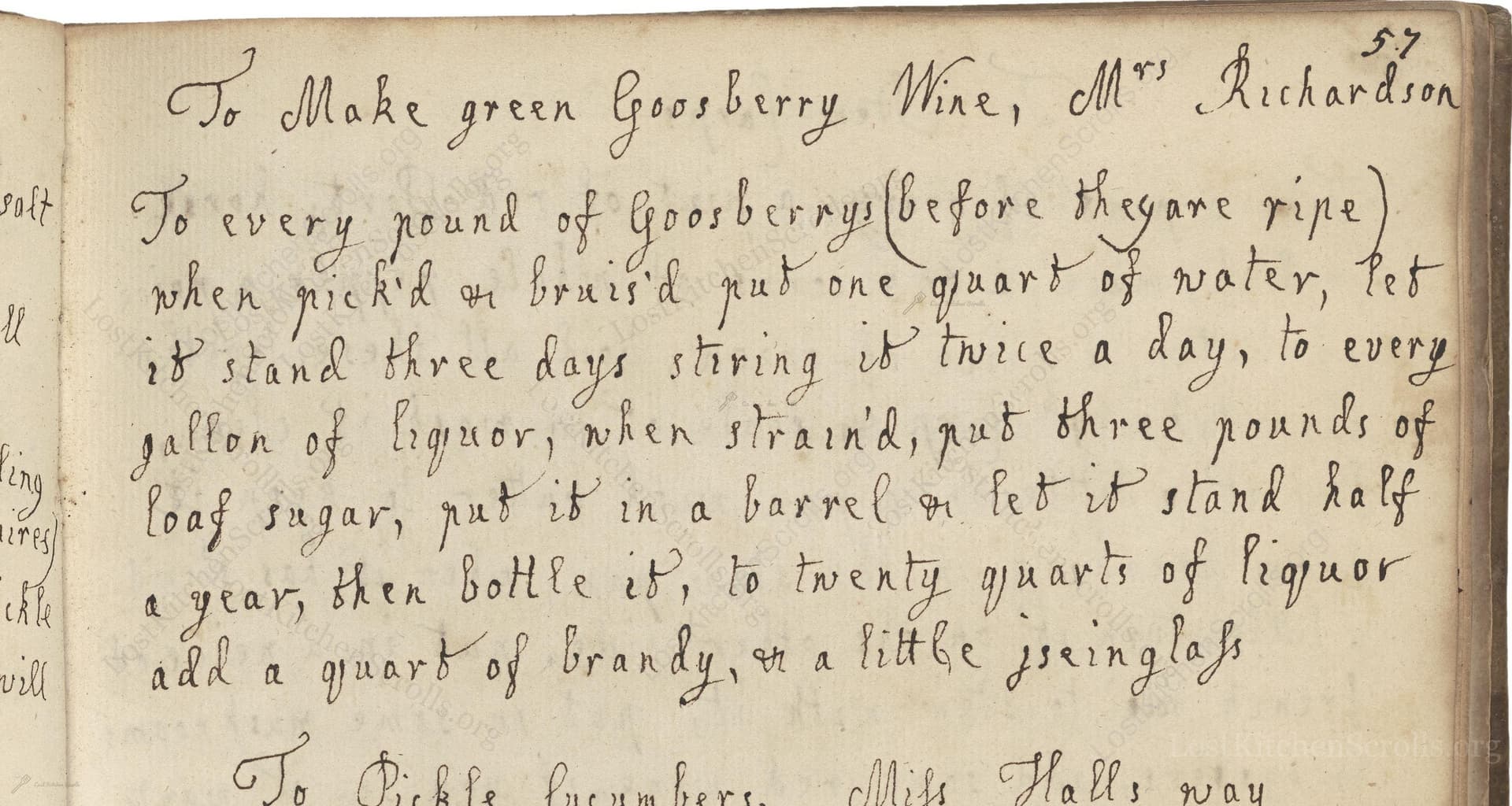To Make Green Goosberry Wine, Mrs Richardson
From the treasured pages of Cookbook of 1720
Unknown Author

To Make Green Goosberry Wine, Mrs Richardson
"To every pound of Goosberrys (before they are ripe) when pick'd or bruis'd put one quart of water, let it stand three days stiring it twice a day, to every gallon of liquor, when strain'd, put three pounds of loaf sugar, put it in a barrel & let it stand half a year, then bottle it, to twenty quarts of liquor add a quart of brandy, or a little isinglass"
Note on the Original Text
The recipe is written in plain, flowing prose, typical of early 18th-century English manuscripts. Measurements are based on practical domestic units like 'pound,' 'quart,' and 'gallon,' with sugar referred to as 'loaf sugar,' the standard of the time. Spellings like 'Goosberrys' and 'stiring' reflect period conventions and the absence of standardized spelling before the late 18th century. Instructions are brief, trusting in the housekeeper’s knowledge and experience for the details of fermentation and bottling.

Title
Cookbook of 1720 (1720)
You can also click the book image above to peruse the original tome
Writer
Unknown
Era
1720
Publisher
Unknown
Background
Step back to the early 18th century and discover a delightful treasury of recipes and culinary secrets, where traditional flavors meet timeless technique—a feast for curious cooks and history lovers alike.
Kindly made available by
Folger Shakespeare Library
This recipe comes from early 18th-century England (circa 1720), when country housewives and gentlewomen delighted in making wine from garden fruits as a thrifty alternative to imported wines. Gooseberry wine was prized for its refreshing taste and festive sparkle. The recipe is attributed to Mrs. Richardson, likely a housekeeper or lady of the house, and was preserved in a manuscript collection of household secrets, reflecting the domestic skill and ingenuity of the period.

The original method required large earthenware or wooden tubs for macerating and fermenting the fruit, a wooden or metal stirring paddle, linen cloths or fine sieves for straining, barrels or stoneware jars for aging, and glass bottles sealed with cork or wax. Some kitchens may have used a hand-cranked fruit crusher or simply a wooden pestle. The addition of isinglass or brandy would require careful measuring and mixing tools.
Prep Time
20 mins
Cook Time
0 mins
Servings
10
We've done our best to adapt this historical recipe for modern kitchens, but some details may still need refinement. We warmly welcome feedback from fellow cooks and culinary historians — your insights support the entire community!
Ingredients
- Underripe gooseberries, 1 lb
- Water, 1 quart
- Granulated sugar (as substitute for loaf sugar), 12 oz per quart strained liquid
- Brandy, 2 oz per quart strained liquid (optional)
- Isinglass (optional, or use gelatin sheets as clarifier)
Instructions
- To make historical gooseberry wine, start with underripe gooseberries for a fresh, tart note.
- For each 1 lb of gooseberries, bruise or crush them gently, and add 1 quart of water.
- Let the mixture stand in a clean container for three days, stirring it twice daily.
- After three days, strain the liquid and measure the volume.
- For every 1 gallon of liquid, stir in 3 lbs of white granulated sugar.
- Pour the sweetened liquid into a sanitized fermenting vessel, seal, and leave it to ferment and mature for six months in a cool, dark place.
- After six months, bottle the wine.
- (If making five gallons, add 1 quart of brandy before bottling for extra strength and preservation, or a little isinglass as a clarifier—gelatin may be substituted.) Age further in bottle before serving.
Estimated Calories
120 per serving
Cooking Estimates
You will spend about 20 minutes preparing the gooseberries and mixing ingredients. The recipe then needs to stand for three days before straining, followed by a six-month fermentation. Each serving contains about 120 calories, and the recipe makes about 10 servings per batch if you start with 450g of gooseberries.
As noted above, we have made our best effort to translate and adapt this historical recipe for modern kitchens, taking into account ingredients nowadays, cooking techniques, measurements, and so on. However, historical recipes often contain assumptions that require interpretation.
We'd love for anyone to help improve these adaptations. Community contributions are highly welcome. If you have suggestions, corrections, or cooking tips based on your experience with this recipe, please share them below.
Join the Discussion
Rate This Recipe
Dietary Preference
Main Ingredients
Culinary Technique
Occasions

Den Bockfisch In Einer Fleisch Suppen Zu Kochen
This recipe hails from a German manuscript cookbook compiled in 1696, a time whe...

Die Grieß Nudlen Zumachen
This recipe comes from a rather mysterious manuscript cookbook, penned anonymous...

Ein Boudain
This recipe comes from an anonymous German-language manuscript cookbook from 169...

Ein Gesaltzen Citroni
This recipe, dating from 1696, comes from an extensive anonymous German cookbook...
Browse our complete collection of time-honored recipes



